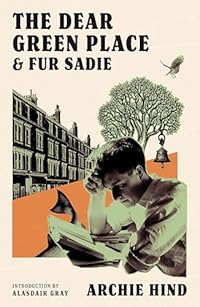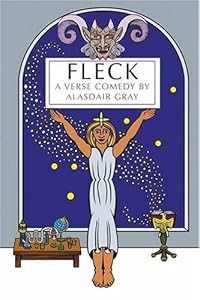Polygon, 2008, 248 p, plus viii p introduction by Alasdair Gray. In The Dear Green Place and Fur Sadie.
Borrowed from a threatened library. (One of the 100 Best Scottish Books.)
Many Scottish novels betray a love of the country’s landscape, some even start with descriptions of it. So too it is with The Dear, Green Place, except – the place in question being Glasgow – it’s a cityscape we are reading about. Glasgow’s name is supposedly from the Gaelic Gles Chu, (“the dear green place”) the location where St Mungo (St Kentigern in the Celtic) built his little church and founded the settlement which became the second city of the empire. As described here, “A Calvinist, Protestant city. The influx of Roman Catholic Irish and Continental Jews had done nothing to change it. Even they in the end became Calvinist.” (This is true not just of Glasgow but reflective of Scotland as a whole.)
Our protagonist, Mat Craig, thinks of the city that, “the foundries, steelworks, warehouses, railways, factories, ships, the great industrial and inventive exploits seemed to give it all a kind of charm, a feeling of energy and promise,” and finds pride in the thought that during the (1945-51) Labour Government’s first term of office domestic life changed from sordidness and squalor to become decent. Like many a working man of the times he is well read – the text is peppered with references to art and literature, in particular to Thomas Mann – and capable of finding the dynamic sublime in the dripping of raindrops from one rail of a fence to another. “The dynamic sublime. A wee Glesca one. All on a reduced scale.” On New Year celebrations he feels that it is, “good in the depth of winter to have a formal and ceremonious occasion for the release of inhibitions, but in Glasgow drink still leaves the sober certainty of the bitterness of life and the inexorable passage of time.”
His great ambition is to be a writer but his mother is against him getting above himself. She complains when he gives up his office job, “It’s a guid respectable job with a collar and tie.” He replies, “Aye. It’s respectable. And I’m fed up to the teeth with respectability. As soon as anyone shows any sign of gumption you want him to become respectable. Put a collar and tie on. It’s in case they’ll bite. They’re frightened they’ll bite. And so they will. The ones that don’t get collared.” But, he thought, he would always have to make concessions to others just because he loved them. “It was exactly thus that conscience makes cowards of us all.”
He marries and to make ends meet goes to work alongside his brother in a slaughterhouse. There are vivid descriptions of the processes involved in rendering an animal fit for human consumption. He meets with minor success with a few short stories written in a style he knows will sell but completing his novel is a more elusive task. Even stopping work and living on his and his wife’s savings isn’t enough. He feels a deep attachment to his art, “obliging him to accept the arrogant task of creating art out of deprivation rather than choose the easy way of leaving deprivation behind him…. To attempt the difficult, almost impossible task of making art out of his Scottishness rather than turn towards a sophisticated, successful but alien tradition.”
On the death of his father in a lorry accident he thinks, “everything in human life – the everyday common tasks, sex, love, contentment, aspiration, ordinary human intercourse, hope, laughter, were like dirty snivelling little secrets being uncovered by this sneering, wicked, expedient, mechanistic force that was the world,” and conceives “a story of this bonny wean, of a gifted child who’d scatter his useless gifts about the world; a story of prodigality, of waste, of squandering, which would contain all his sourness, pessimism and accusation; and his love too.”
An intensely literary book, The Dear, Green Place is about the struggle to stay yourself and be true to a vision, and the difficulties that lie along that path. And a reminder that knowledge and deep thinking do not belong exclusively to the well-heeled.
According to Alasdair Gray’s introduction (again I left this till after reading the book) Hind’s shorter works – plays, radio scripts and some short stories – are now lost. All that remains of his œuvre is contained within this book’s covers. The Dear, Green Place is the major part and acts in contrast to the stereotypical view of Glasgow and its inhabitants as portrayed in the likes of No Mean City. Gray tells us that Gles Chu has been previously translated as green hollow, green churchyard, greyhounds ferry, dear stream, and later, in Glasgow’s industrial, imperial pomp, grey forge or grey smithy but that the dear green place, Hinds’s own translation, is now generally accepted. Though sometimes, still – even now the smoke and the industry have largely gone – that description can seem inapt, the city does have an abundance of parks and leafy spaces.
The other large story in these covers is the unfinished Fur Sadie, the story of Sadie Anderson, a woman with perfect pitch – her ‘doh’ (in her head she can translate intervals and chords into sol-fa) – who, remembering her childhood friend Anna Berman playing the piano, in middle age buys one of her own and starts to get lessons – despite the incomprehension and teasing she receives from her husband, Alec, and sons, Hugh and Colin. In a pun on musical terminology and the position of a working class woman of her time Hind tells us Sadie had always known how to diminish. Despite many years of marriage and three children together Sadie and Alec had never seen one another naked, “A terrible modesty that excluded sexuality from the commonplace acts of the day and, denying ordinary acts of touching and looking, denied a way of expressing tenderness.” This “modesty” surrounding the human body (pudency would be an even more apt term) was an all too prevalent tendency in a Scotland steeped in Calvinism. The story’s title is not only a reference to Beethoven’s piano composition Für Elise but also to the way the word “for” is pronounced in Glasgow dialect. Fur Sadie acts as a companion piece to The Dear, Green Place in that it features another working class protagonist with aspirations to artistic endeavour but it has a more optimistic feel. It’s a pity it is incomplete (apparently Hind said, “It developed a slow puncture,”) as Sadie is an engaging character and this reader of the fragment was definitely left wanting more.
The final prose piece in the book, The Men of the Clyde, appeared in Scottish International, August 1973, and is an encomium to the workers of the Upper Clyde Shipbuilders work-in. Lastly there is a song lyric, The Dear Green Place, (composed with Peter Kelly) from a review Through with a Flourish presented at the Edinburgh International Festival in 1971.
Pedant’s corner:- compatability, (compatibility,) grills (grilles,) rough shod (roughshod,) in a list “paraffin. turpentine,” (paraffin, turpentine,) octopi (octopuses or, the Greek plural, octopodes,) the cuticle of the nails (cuticles would be more correct,) tick (tic,) Anna’s surname flicks from Bermant to Berman and back,) worried at lot (worried a lot,) piano stood (stool,) just that same (just the same,) waked in (walked in,) rubbing a corned (corner,) “Beethoven’s sly double use of the piece, which was for Elsie in the concession to unlearned fingers and that it was for Elsie in that it seemed to express, sensuously, her young bloom” (should not both these Elsies be Elises?)









